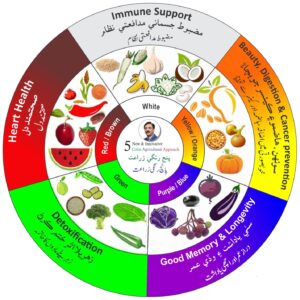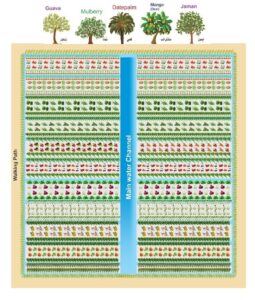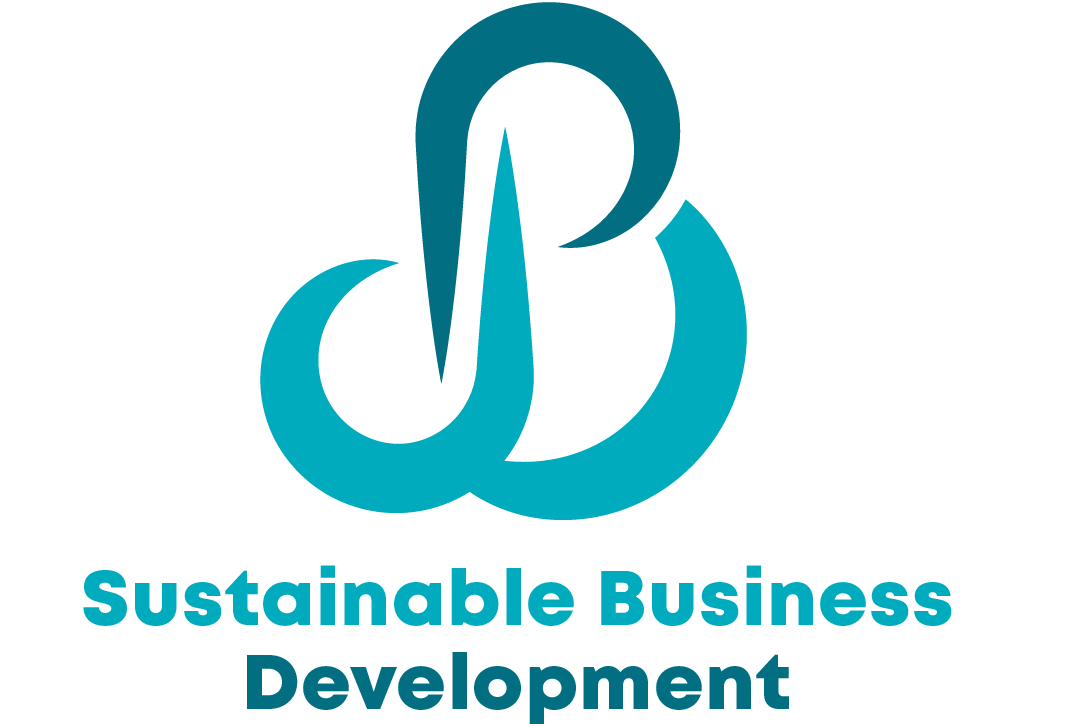 Sustainable Business Development (SBD) has launched an innovative project titled “Public Health and Diversified Food (5-Color Nutrition Sensitive Agriculture)” to emphasize the critical connection between public health and access to diverse nutrition.
Sustainable Business Development (SBD) has launched an innovative project titled “Public Health and Diversified Food (5-Color Nutrition Sensitive Agriculture)” to emphasize the critical connection between public health and access to diverse nutrition.
Public health is fundamentally linked to the availability and consumption of diversified food, which ensures that populations receive the essential nutrients necessary for a healthy life. A balanced and varied diet—including fruits, vegetables, grains, proteins, and micronutrients—plays a crucial role in preventing malnutrition, strengthening immunity, and reducing the risk of chronic diseases like diabetes, heart conditions and anemia.
The project is founded on the 5-Color Nutrition Sensitive Agriculture approach, developed by the renowned agriculture expert, researcher, writer, media person and trainer, Mr. Mustafa Nangraj. With his consent and endorsement, SBD has adopted this innovative framework as a key component of its initiative to revolutionize public health through nutrition-sensitive agriculture.
revolutionize public health through nutrition-sensitive agriculture.
This initiative aims to promote diversified food systems that foster sustainable agriculture and improve food security. By addressing both nutritional and environmental challenges, it seeks to raise awareness and ensure access to diverse diets, contributing to the development of healthier and more resilient communities.
As part of this project, SBD leverages its extensive capacity to conduct research and provide consultancy services to institutions, NGOs, individuals, international clients, and businesses. The organization specializes in developing and customizing business development plans and proposals, along with offering tailored training programs based on client demands. This flexible approach ensures impactful and sustainable solutions for stakeholders involved in nutrition-sensitive agriculture and public health.
This project marks a significant step in bridging the gap between nutrition, agriculture, and public health, empowering communities and institutions to foster a healthier and more sustainable future.
The 5-Color Nutrition Sensitive Agriculture Model: Structure and Innovations
The 5CNSA model stands out for its integration of nutrition-sensitive agriculture with a unique 5-color cultivation strategy. This approach directly addresses land scarcity and dietary diversity through innovative crop grouping and layered cultivation. The model promotes cultivating crops across five color groups—red/brown, green, yellow/orange, white, and purple/blue—each delivering unique phytonutrients essential for health. Furthermore, the 3-layer raised bed cultivation technique allows farmers to maximize limited land space, creating a sustainable and resource-efficient system.
Color-Based Crop Groups, Nutritional and Health Benefits
Each crop color group is associated with distinct health benefits, contributing to the 5CNSA model’s emphasis on dietary diversity:
- Red/Brown Crops (e.g., tomatoes, carrots, jujube, date palm, chilies, red beans): Rich in antioxidants that support heart health.
- Green Crops (e.g., leafy greens, green beans, guava, pearl millet, broccoli): Important for body detoxification, containing vitamins and minerals essential for blood and bone health.
- Yellow/Orange Crops (e.g., pumpkins, mango, papaya, oranges, gram pulse): Enhances beauty, prevents cancer, improves digestion, and contains beta-carotene for vision and immune support.
- White Crops (e.g., mushrooms, cauliflower, radish, onions, garlic, mulberry): Offers anti-inflammatory properties, boosting immunity.
- Purple/Blue Crops (e.g., eggplants, berries, Jamun{ Syzyguim cumini}, Falsa / Phalsa { Grewia asiatica}): Supports cognitive function, memory, longevity, and reduces inflammation, aiding mental health.
3-Layer, 5-Color Nutrition-Sensitive Agricultural Cultivation Technology
Mr. Mustafa Nangraj has pioneered the innovative 3-layer cultivation technology, which integrates the concept of growing color-diverse crops on a single plot using a layered approach. This technique allows farmers to cultivate crops in three distinct layers, optimizing land use, reducing input costs, and significantly enhancing yield density.
plot using a layered approach. This technique allows farmers to cultivate crops in three distinct layers, optimizing land use, reducing input costs, and significantly enhancing yield density.
Field trials conducted by Mr. Nangraj in Sindh have shown that this method enables farmers to achieve up to 35% higher yields compared to traditional farming practices. By addressing critical issues such as land constraints and malnutrition, this technology offers a sustainable solution for improving smallholder productivity and nutritional outcomes.
Addressing Malnutrition and Health Costs
Field assessments and community surveys reveal that rural households often grow cash crops or staple grains, resulting in low dietary diversity. The 5CNSA model addresses this issue by promoting the cultivation of nutrient-dense foods, which reduces household health costs and improves productivity. According to my findings, families adopting the 5CNSA model report fewer health issues, reduced healthcare expenses, and enhanced work productivity. This shift is particularly critical in rural Pakistan, where limited healthcare access makes preventive health measures essential for long-term well-being.
Environmental and Economic Benefits of the 5CNSA Model
The 5CNSA model also emphasizes climate resilience, resource efficiency, and income generation, making it an environmentally and economically sustainable framework that aligns with global climate and sustainability goals.
- Climate Resilience: The color-diverse crop selection and 3-layer cultivation enhance resilience against climate shocks, ensuring consistent productivity in variable environmental conditions and reducing crop failure risks.
- Resource Efficiency: The 3-layer raised bed technique conserves resources, especially water, which is critical in water-scarce regions like Sindh. This technique optimizes water usage per layer, reducing the water footprint of crop cultivation by up to 30%.
- Economic Benefits: The 5CNSA model offers a 30-50% increase in income due to the ability to cultivate and sell multiple crops from the same land area. This economic resilience helps farmers stabilize income amid market volatility and rising input costs, supporting long-term sustainability.
Integration of 5CNSA into Public Health Policy and Intervention Programs
The 5CNSA model aligns seamlessly with public health goals, providing a valuable framework for nutrition-sensitive agricultural interventions. Incorporating the model into national and regional health policies could facilitate preventive health measures that reduce reliance on healthcare systems over time. Key policy recommendations for integrating the 5CNSA model include:
- School Feeding Programs: Incorporating 5-color foods into school meal programs can directly address child malnutrition and establish lifelong healthy eating habits.
- Community Health Campaigns: Health ministries can utilize community-based campaigns to promote the 5-color approach, emphasizing dietary diversity for immunity, growth, and cognitive development.
- Training and Capacity Building: Integrating 5CNSA training into agricultural extension services would equip farmers with knowledge of both the nutritional and economic benefits of diverse crop cultivation.
Global Applicability and Replication Potential
The 5CNSA model’s principles make it adaptable to countries facing similar agricultural, nutritional, and environmental challenges. Potential regions for 5CNSA adaptation include:
- Sub-Saharan Africa: Countries like Ethiopia and Kenya, where land fragmentation and nutrient deficiencies are prevalent, could benefit from the resource-efficient, income-enhancing strategies of 5CNSA.
- South Asia: In water-scarce areas of India and Bangladesh, the 3-layer cultivation system could optimize yield and improve nutritional diversity.
- Middle East and North Africa (MENA): Countries with severe water limitations, such as Egypt and Jordan, could utilize 5CNSA’s water-smart practices to maximize productivity sustainably.
SBD: Delivering Transformative Agricultural Solutions
Sustainable Business Development Pvt. Ltd. (SBD) is poised to offer its expertise in implementing the 5-Color Nutrition Sensitive Agriculture (5CNSA) model at both national and international levels. SBD is ready to collaborate with government organizations, the private sector, NGOs, and individuals, leveraging the knowledge and skills of its experts to drive impactful change.
The 5CNSA model represents a groundbreaking approach to sustainable agriculture, nutrition, and public health. By utilizing its innovative 3-layer cultivation technique, emphasizing color-diverse crop cultivation and a communication approach, this model effectively tackles critical challenges such as land fragmentation, water scarcity, malnutrition, and economic resilience.
Its alignment with public health goals and adaptability across diverse global contexts make it a replicable and scalable framework. With sustained research, policy backing, and international cooperation, the 5CNSA model can play a pivotal role in global efforts to combat malnutrition and promote sustainable agricultural practices, fostering a healthier and more resilient world.
